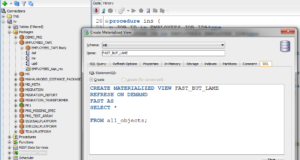REQUEST COMPLIMENTARY SQLS*PLUS LICENCE
Oracle VIEW

In this material you will learn how to use, create, update and delete Oracle VIEW with syntax and examples.
What is VIEW in Oracle?
In Oracle, VIEW is essentially a virtual table that does not physically exist. Most likely, it is created by querying one or more tables.
CREATE VIEW
CREATE VIEW syntax in Oracle
CREATE VIEW view_name AS
SELECT columns
FROM tables
[WHERE conditions]
Parameters or arguments
- view_name – The name of the Oracle VIEW that you want to create.
- WHERE conditions – Optional. Conditions that must be met for entries to be included in VIEW.
Example:
CREATE VIEW sup_orders AS
SELECT.supplier_id, orders.quantity, orders.price
FROM suppliers
INNER JOIN orders
ON.supplier_id = orders.supplier_id
WHERE suppliers.supplier_name = 'Microsoft';
This Oracle CREATE VIEW example will create a virtual table based on the resulting SELECT set. You can now query Oracle VIEW as follows:
SELECT *
FROM sup_orders;
Update VIEW
With Oracle CREATE OR REPLACE VIEW you can change what is defined in Oracle VIEW without removing it.
Syntax of CREATE OR REPLACE VIEW in Oracle
CREATE OR REPLACE VIEW view_name AS
SELECT columns
FROM table
WHERE conditions;
- view_name – The name of the Oracle view that you want to create or change.
The name of the Oracle view that you want to create or change:
CREATE or REPLACE VIEW sup_orders AS
SELECT.supplier_id, orders.quantity, orders.price
FROM suppliers
INNER JOIN orders
ON.supplier_id = orders.supplier_id
WHERE suppliers.supplier_name = 'Apple';
This Oracle CREATE OR REPLACE VIEW example will update the Oracle defined sup_orders view without removing it. If Oracle VIEW did not already exist, the view will be created for the first time.
Drop VIEW
Once VIEW has been created, you can delete it using the DROP VIEW.
DROP VIEW syntax in Oracle
DROP VIEW view_name;
- view_name – The name of the Oracle view you want to create or replace.
Below is an example of how to use Oracle DROP VIEW:
DROP VIEW sup_orders;
This Oracle DROP VIEW example will delete the view named sup_orders.
Frequently Asked Questions
Q: Can I update my data in VIEW?
A: An Oracle view is created by combining one or more tables. When you update a VIEW record(s), the base table records that make up VIEW are updated.
So, yes, you can update the data in Oracle VIEW if you have the appropriate privileges in the Oracle base tables.
Q: Will Oracle VIEW exist if the table is removed from the database?
A: Yes, in Oracle VIEW exists even after one of the tables (on which VIEW is based) is removed from the database. However, if you try to query Oracle VIEW after a table has been deleted, you will get a message that Oracle VIEW contains an error.
If you recover the table (the table that was deleted), Oracle VIEW will be fine again.
SQL tutorial: SQL View in Oracle Database
MORE NEWS
PreambleNoSql is not a replacement for SQL databases but is a valid alternative for many situations where standard SQL is not the best approach for...
PreambleMongoDB Conditional operators specify a condition to which the value of the document field shall correspond.Comparison Query Operators $eq...
5 Database management trends impacting database administrationIn the realm of database management systems, moreover half (52%) of your competitors feel...
The data type is defined as the type of data that any column or variable can store in MS SQL Server. What is the data type? When you create any table or...
PreambleMS SQL Server is a client-server architecture. MS SQL Server process starts with the client application sending a query.SQL Server accepts,...
First the basics: what is the master/slave?One database server (“master”) responds and can do anything. A lot of other database servers store copies of all...
PreambleAtom Hopper (based on Apache Abdera) for those who may not know is an open-source project sponsored by Rackspace. Today we will figure out how to...
PreambleMongoDB recently introduced its new aggregation structure. This structure provides a simpler solution for calculating aggregated values rather...
FlexibilityOne of the most advertised features of MongoDB is its flexibility. Flexibility, however, is a double-edged sword. More flexibility means more...
PreambleSQLShell is a cross-platform command-line tool for SQL, similar to psql for PostgreSQL or MySQL command-line tool for MySQL.Why use it?If you...
PreambleWriting an application on top of the framework on top of the driver on top of the database is a bit like a game on the phone: you say “insert...
PreambleOracle Coherence is a distributed cache that is functionally comparable with Memcached. In addition to the basic function of the API cache, it...
PreambleIBM pureXML, a proprietary XML database built on a relational mechanism (designed for puns) that offers both relational ( SQL / XML ) and...
What is PostgreSQL array? In PostgreSQL we can define a column as an array of valid data types. The data type can be built-in, custom or enumerated....
PreambleIf you are a Linux sysadmin or developer, there comes a time when you need to manage an Oracle database that can work in your environment.In this...
PreambleStarting with Microsoft SQL Server 2008, by default, the group of local administrators is no longer added to SQL Server administrators during the...















